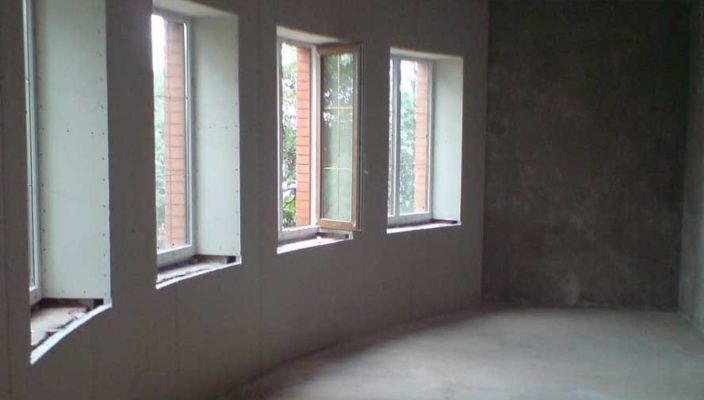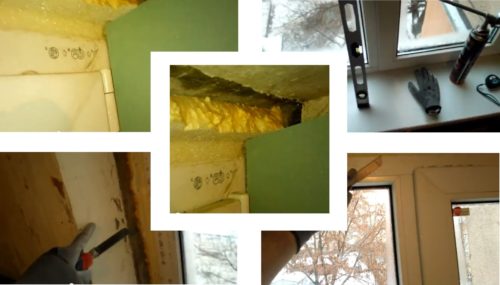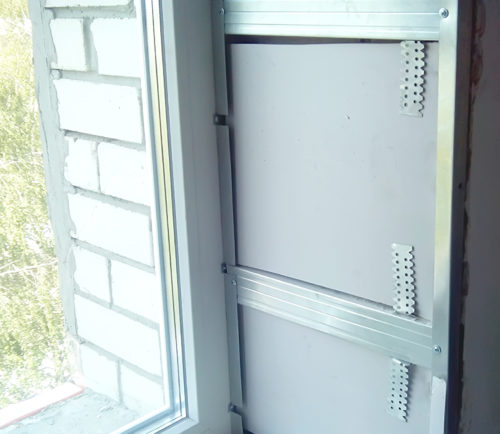Installing new windows is completed by the sloping device. This is done not so much to create an attractive appearance, how much to improve the waterproofing and thermal insulation properties of window openings. Now it will be about the installation of slips from drywall.
Content
Purpose of slips from drywall
High-quality fastening of plastic windows involves the correct place of place of adjuncing frames to the walls. In this mounting junction, the "bridges" of the cold, through which air from the street in the winter will fall into residential rooms.
For this reason, mounting joints should be hermetic and warm. The main task is the absolute protection of the outer docking layer. In most cases, assembly foam applies for these purposes.
But this material has such disadvantages as absorption of moisture and destruction under the influence of sunlight. And this is fraught with a decrease in the thermal insulation qualities of the mounting foam. To avoid these phenomena, there are slopes.
One of the most optimal solutions - slopes, for the manufacture of which are used drywall sheets. This material is characterized by environmental friendliness and has an attractive appearance.
The advantages of slips from drywall include:
- simplicity and speed of installation work;
- creating a perfect smooth surface;
- solid operational period;
- obtaining proper geometry of the window (door);
- excellent thermal insulation properties;
- low price.
The only nuance is to choose a facing material. Plasterboard for slopes should be moisture-resistant. If there are pieces of ordinary drywall, it should be treated with moisture resistant composition and primer on both sides. The minimum thickness of the finishing material is 12 mm.
How to make slips from drywall. Preparatory stage
At the preliminary stage, all communication lines are stored through the doors or windows (electrical wiring, antenna and telephone cables, wire for the Internet and call).
According to the instructions for the installation of plasterboard slopes, all angles and distances from them are measured in several places to jambs. This is due to the fact that sometimes the height of the openings has different sizes.
All made measurements are transferred to plasterboard. Points are connected by lines and the final measurements are made again. After that, cutting the necessary workpieces of the material.
To cut the drywall, you can use the stationery knife:
- a ruler is applied to the drawn line;
- it makes the movement with a knife (with a cut of cardboard and gypsum cut);
- under the line of the outbreak, a wooden bar is led;
- along the cut is closed with hand;
- the plaster part is cleaned;
- the lower side of the drywall is cut.
The process of creating slips from drywall can be carried out with their own hands on three technologies:
- on the mounting foam;
- on glue;
- on the frame.
How to make slips from drywall. Mounting foam
This technology is the most simple. Due to its use, the maximum thermal insulation of the surface is achieved. The device of slips from drywall is proceedable in the absence of large depressions. If in the slopes there are deposits of the size of over 3 cm, they should be selected by cement mortar and mounting foam.
Technology for creating slopes using mounting foam consists of the following steps:
- purification of surfaces from dust;
- application on the back of the plasterboard mounting foam to 1 cm thick;
- pressing the blank to the wall;
- temporary removal of the item so that the foam remains on the sheet and the wall;
- after increasing the volume of foam (5-10 minutes), the billet is mounted in place and pressed;
- the rest of the slopes are attached;
- after a day, the slit between the wall and plasterboard is closed with plastering solution.
This method has significant disadvantages:
- there is a high probability of brave protection;
- the presence of emptiness;
- not the most reliable fastening.
Alternatively, it is recommended to resort to such actions:
- in the drywall there are several holes at 4-5 cm from the windowsill (windows);
- the billet is fixed to the wall with several screws;
- mount the struts;
- in the holes inserted the tube from the cylinder;
- installation foam injected;
- a day later, the struts are removed and the excess foam is cut.
How to make slips from drywall. Glue
As in the above-described technology, the slips from the drywall are made after careful removal from the surface of the old coating and dust. All cracks are sealed with a plaster solution, and the slopes are ground. Only after drying the primer can be processed to the creation of drywall billets and applying glue.
If there is a smooth slope, you can use glue for ceramic tiles. But it is better to take advantage of the special composition (for example, Knauf Perflix). When preparing glue, the fact of its rapid grapping should be taken into account. The resulting mixture must be used for 30-40 minutes. It is forbidden to add water when grasping glue. This is fraught with a decrease in the adhesion qualities of the composition.
The technique of sticking of slopes implies:
- the formation of ball glue (their size is determined, based on the distance between the old slope and the new billet);
- fixing balls on the wall in increments of 0.1-0.3 m;
- applying and embarrassing drywall rubber hammer through a smooth bar (this ensures the rapid drying of the composition);
- grapping the working solution.
If the old slope has drops of heights above 3 cm, the drops are previously carried out by gluing drywall pieces. The vertical band of plasterboard slope is mounted using spacers that are removed after graspting glue (1-2 hours).
After a few days after complete drying of the emptiness solution between the slopes and the wall are filled with mounting foam.
How to make slips from drywall. Frame
The most reliable way to fasten the slips from drywall is a framework of the frame. For these, you can use wooden slats or galvanized profiles. The latest products are the best option, since not all wooden rails can "boast" a smooth surface.
Creating a frame begins after hardening the mounting foam around the perimeter of windows or doors. Guides are exhibited in the corner and along the shock of the opening. Between profiles at a distance of 0.5-0.7 m are made jumpers. In places of drywall and frames, profiles are fixed using metal screws.
A distinctive feature of this technology for creating slopes is that the marking works and cutting of drywall is carried out only after mounting the frame structure. For fastening drywall to profiles use self-draws for metal. It is done very carefully. With a strong tightening fasteners, the gypsum part of the slope can burst.
Registration of outdoor corner
At the final stage, the slots and the "elimination" of the outer corner are taken. For the sealing of large cracks, a painting tape of fiberglass is used, which is covered with finishing putty. If the cracks are small, then they are enough to close with putty.
The location of the junction with windows can be filled with acrylic glue of white. The dried acrylic will become rubber and does not crack.
For registration of the outer corner, perforated corners of metal are used. They are exhibited by level in one plane with the wall and covered with a thick putty. The next day, all plasterboard slopes are so ground. After grinding the surface is ready for painting or finishing with wallpaper.
Video on the installation of plasterboard slopes:
























